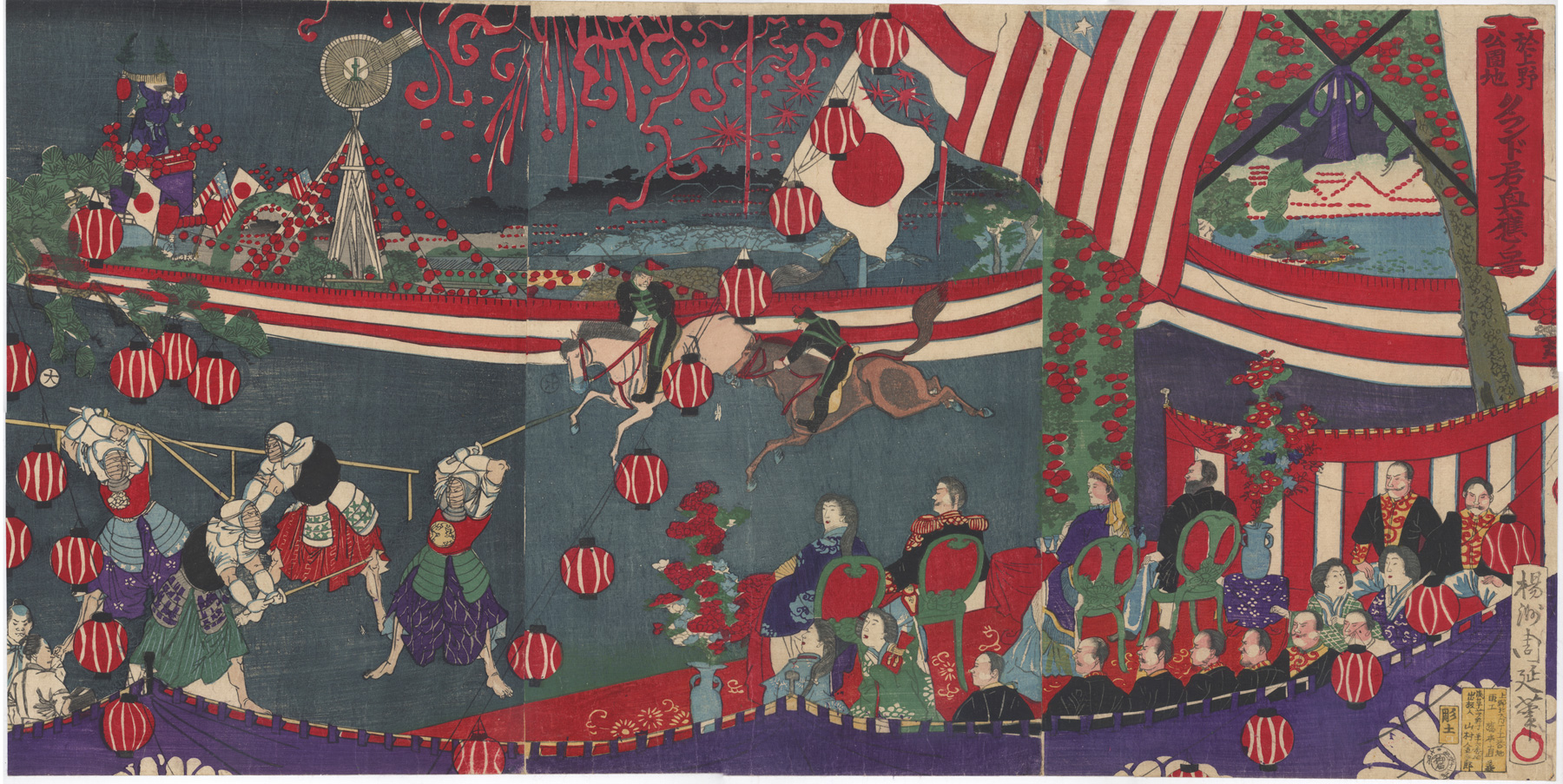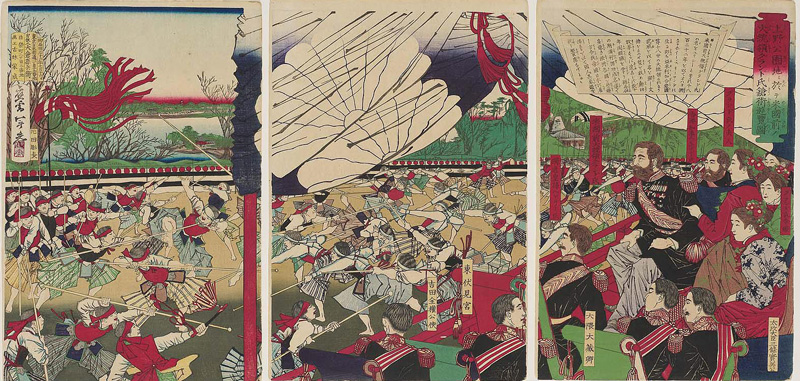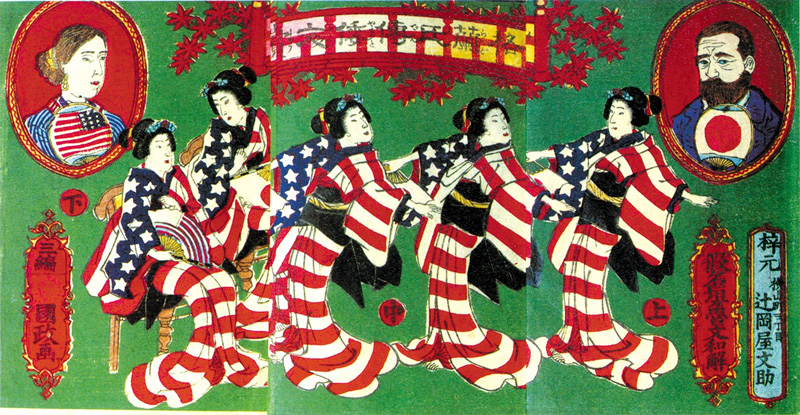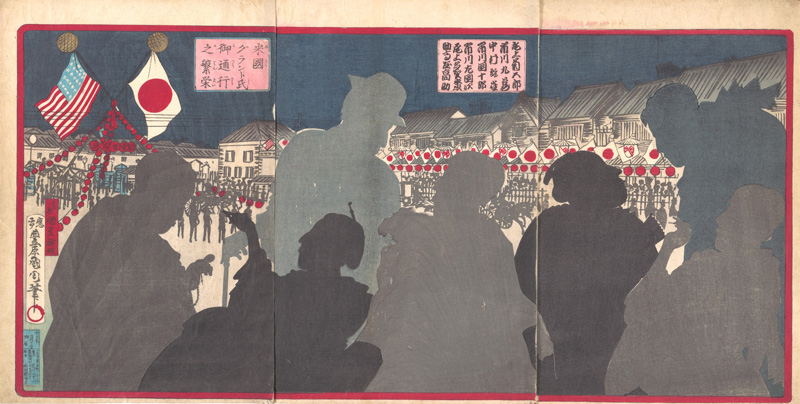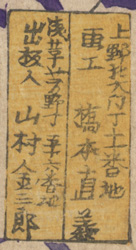About This Print
Conceived in early July 1879, over a month before the actual celebration for former President Grant in Ueno Park on August 25, this print was the artist's invention, based upon the announced festivities. In this print we see Mr. and Mrs. Grant seated on the viewing platform with Emperor Meiji and Empress Shōken, while displays of kendo, horsemanship and fireworks entertain them. While the artist depicts the presence of the Empress, there is no record of her attending the festivities, although she did meet the Grants on another occasion during their Tokyo visit.
Ex-president Grant was extremely popular in Japan, but as Donald Keene points out "...surely many in the crowds that cheered Grant had shouted anti-foreign slogans a dozen years earlier, and some may have planned to kill every foreigner in sight. Hatred has mysteriously turned to love. The plain former soldier had captured the hearts of the Japanese, even the emperor, not by presenting rich gifts but by his unaffected ways and his delight in Japan."1
Three Other Prints Commemorating the Celebration
Former President of the United States, Mr. Grant,
Watching a Lance Training Exhibition at Ueno Park, July 16, 1879
by Kobayashi Toshimitsu
source: Museum of Fine Arts, Boston 2000.221a-c
The World Tour of Mr. and Mrs. Grant
Japan was the last stop on ex-President and Mrs. Grant's two and a half year around the world tour, begun on May 17, 1877 and ending on September 3, 1879. His seventy-four days in Japan, from June 21, when his ship landed in Nagasaki, to September 3, 1879, when he departed from Yokohama for San Francisco, were the capstone to his trip, and he received an unprecedented exuberant reception throughout his visit, culminating with an audience with Emperor Meiji on July 4 followed by a public festival in Ueno Park on August 25, 1879 attended by Emperor Meiji.
The July 4 Audience with the Emperor
Arriving in Tokyo by train on July 3rd, Grant was informed that he would be received by the 27 year old Emperor the next day, July 4 at the Imperial Palace. After being congratulated by the Emperor on the anniversary of American independence, Grant thanked the Emperor for the "great kindness" he had been receiving and confirmed the mutual friendship between the two nations, going on to say "America is your next neighbor, and will always give Japan sympathy and support in her efforts to advance. I again thank your Majesty for your hospitality, and wish you a long and happy reign, and for your people prosperity and independence."2
During his stay in Japan, Grant was to make a number of recommendations to the Emperor and his advisers, leaving a "deep impression" on the young Emperor. One area Grant discussed with the Emperor was the ongoing conflict between China and Japan over the Ryukyus, to which he hoped for a peaceful and equitable solution.
Grant had been offended by the elitist, racist rhetoric coming from Western powers regarding China and Japan, and convinced Meiji that any country, if included in negotiations, would attempt to financially cripple both countries for the benefit of their own. "Sometimes my blood boils," Grant said, "to see this unfairness and selfishness." To the general, it was a marvel that Japan kept its temper and continued its "kind treatment to the foreigners under the insults heaped upon them" from the "overbearing and bullying policy of the foreigners and their diplomatic representations.”3
The August 25 Ueno Park Celebration
The culmination of Grant's visit was a festival, open to the public, in Ueno Park. Organized by the Committee for Ueno Reception, comprised of leading business and political figures, the committee arranged, through the Imperial Household, the Emperor's attendance, ensuring a large public turnout. As described by Richard T. Chang in his article "General Grant's 1879 Visit to Japan," appearing in the journal Monumenta Nipponica, "No event in the visit of General Grant excited more attention than did this festival."
A grand parade preceded the festival. Grant and his entourage rode in the Emperor's state carriages, preceded and surrounded by cavalry, and going at a slow pace, so that the crowd could see the General. The people, as the General's carriage came near, would rush to the windows and look in. Every house was decorated with flags and lanterns.
Upon arrival in Ueno Park, as a memento of his visit General Grant planted a Lawson cypress, Mrs Grant an evergreen magnolia, both of which have since grown thick and tall.
The trees planted, the Grants drove to the pavilion prepared for the General. Upon the Emperor's arrival, the General took a seat on the right of the Emperor in a high amphitheater and remained there for an hour, while there were various amusements, mainly feats of horsermanship: lance and sword contest, archery by mounted horsemen, exercises of horsemanship, and twenty-four horsemen with bows and arrows hunting a sham dog. After the Emperor retired, Grant dined with the cabinet members. When the sun set the Grant party returned to their pavilion. After beautiful fireworks, they drove home. The following is Young's [John Russel Young, a correspondent whom the New York Herald sent to accompany Grant] picturesque description of the return procession: "For miles the General's carriage slowly moved through a multitude that might have been computed by the hundreds of thousands, the trees and houses dangling with lamps and lanterns, the road spanned with arches of light, the night clear and mild, all forming a scene the like of which I had never witnessed. It was the culmination of the General's visit to Japan, the highest honor that could be paid him by the Japanese government and people."4
1 Emperor of Japan: Meiji and His World, 1852-1912, Donald Keene, Columbia University Press, 2002, p. 318
2 Japan Today, "Japan Yesterday American President Ulysses S Grant talks peace in Meiji-Era Japan" by Patrick Parr, Sept. 21, 2018 japantoday.com accessed 1/18/2020
3 ibid
4 "General Grant's 1879 Visit to Japan" by Richard T. Chang, Monumenta Nipponica, Vol. 24, No. 4 (1969), p. 373-392.
Print Details
| IHL Catalog | #2075 | ||
| Title or Description | Illustration of President Grant Being Entertained at Ueno Park 於上野公園地 グランド君與應ノ図 於上野公園地 グラント君饗応ノ図 | ||
| Artist | Yōshū Chikanobu (1838-1912) | ||
| Signature |  | ||
| Seal | red Toshidama seal | ||
| Publication七月 Date | 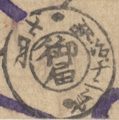 御届 明治十二年七月 Notification delivered of intent to publish (otodoke) July 1879 | ||
| Publisher |
| ||
| Carver | 彫吉 Hori Kichi  | ||
| Impression | goood - consistent with kaika-e of the period | ||
| Colors | excellent | ||
| Condition | good – three sheets joined together with album backing; minor flaws | ||
| Genre | nishiki-e; kaika-e | ||
| Miscellaneous | | ||
| Format | vertical oban triptych | ||
| H x W Paper | 14 x 28 1/4 in. (35.6 x 71.8 cm) | ||
| 14 x 28 1/4 in. (35.6 x 71.8 cm) | |||
| Literature | Nishikie ni miru meiji tenno to meiji jidai [The Meiji Emperor and the Meiji Period as Seen in Nishikie], Tsuneo Tanba, Asahi Shimbun Publishing Co., 1966, pl. 48, p. 46. | ||
| Collections This Print |


